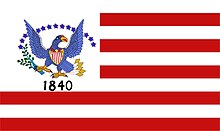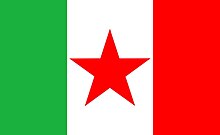United States historic place
| Sutter's Fort | |
| U.S. National Register of Historic Places | |
| California Historical Landmark No. 745 | |
| California Historical Landmark No. 591 | |
 Sutter's Fort, 1840s illustration Sutter's Fort, 1840s illustration | |
   | |
| Location | 2701 L Street Sacramento, California |
|---|---|
| Coordinates | 38°34′20.9″N 121°28′16.4″W / 38.572472°N 121.471222°W / 38.572472; -121.471222 |
| NRHP reference No. | 66000221) |
| CHISL No. | 745 |
| CHISL No. | 591 |
| Added to NRHP | October 15, 1966 |



Sutter's Fort was a 19th-century agricultural and trade colony in the Mexican Alta California province. Established in 1839, the site of the fort was originally part of a utopian colonial project called New Helvetia (New Switzerland) by its builder John Sutter, though construction of the fort proper would not begin until 1841. The fort was the first non-Indigenous community in the California Central Valley, and saw grave mistreatment of Indigenous laborers in plantation or feudal style conditions. The fort is famous for its association with the Donner Party, the California Gold Rush, and the formation of the city of Sacramento, surrounding the fort. It is notable for its proximity to the end of the California and Siskiyou Trails, which it served as a waystation.
In modern times, the adobe structure has been restored to its original condition (38°34′20″N 121°28′16″W / 38.5723°N 121.4712°W / 38.5723; -121.4712) and is now administered by California Department of Parks and Recreation. It was designated a National Historic Landmark in 1961.
History

To build his colony, John Sutter secured a 50,000 acre land grant in the Central Valley from the Mexican governor. The main building of the fort is a two-story adobe structure built between 1841 and 1843 using Indigenous forced labor. This building is the only original surviving structure at the reconstructed Sutter's Fort State Historic Park. It was in here on January 28, 1848, that James Marshall met privately with John Sutter in order to show him the gold that Marshall had found during the construction of Sutter's sawmill along the American River only four days earlier. Sutter built the original fort with walls 2.5 feet (0.76 m) thick and 15 to 18 feet (5.5 m) high. Pioneers took residence at Sutter's Fort around 1841. Following word of the California gold rush, the fort was largely deserted by the 1850s and fell into disrepair.
Construction
The party led by John Sutter landed on the bank of the American River in August 1839. The group included three Europeans and a Native American boy, probably to serve as interpreter. Some of the first people brought to the colony were Native Hawaiian workers, called Kanakas. Sutter had entered a contract with the governor of Hawaii to import and use the labor of these eight men and two women for three years. Once the first camp was set up, Sutter used local Miwok, Nisenan, and "missionized" Native Californians to build the first building, a three-room adobe.
Agricultural colony
Once the fort was built, Sutter established an agricultural colony with labor structures similar to Southern plantations and European feudalism. The colony relied on ranching and growing wheat crops. European colonists oversaw Native Californian and Native Hawaiian workers, who were often gravely mistreated. Sutter employed a caste system to ensure that the minority European settlers maintained control over the colony. Although some of the laborers worked voluntarily, many were subjected to brutal conditions that resembled enslavement or serfdom.
Decline
After gold was discovered at Sutter's Mill (also owned by John Sutter) in Coloma on January 24, 1848, the fort was abandoned.
Preservation

In 1891, the Native Sons of the Golden West, who sought to safeguard many of the landmarks of California's pioneer days, purchased and rehabilitated Sutter's Fort when the City of Sacramento sought to demolish it. Repair efforts were completed in 1893 and the fort was given by the Native Sons of the Golden West to the State of California. In 1947, the fort was transferred to the authority of California State Parks as Sutter's Fort State Historic Park.

Most of the original neighborhood structures were initially built in the late 1930s as residences, many of which have been converted to commercial uses such as private medical practices. The history of the neighborhood is largely residential.
Geography and hydrology

Sutter's Fort is located on level ground at an elevation of approximately 20 feet (6.1 m) above mean sea datum. The slope elevation decreases northward toward the American River and westward toward the Sacramento River. Slope elevation gradually increases to the south and east, away from the rivers. All surface drainage flows toward the Sacramento River. Groundwater in the vicinity flows south-southwest toward the Sacramento Delta. However, after peak rainfall, the Sacramento River swells and the groundwater flow can actually reverse away from the river.
Sutter's Landing
Sutter's Landing is the spot the Captain John A. Sutter landed in August 1839 at the American River after coming up the Sacramento River from Yerba Buena at 38°34′54″N 121°27′58″W / 38.5816°N 121.4660°W / 38.5816; -121.4660. After landing, Sutter built a base camp, then Sutter's Fort. The site of the landing is California Historical Landmark #591 that was listed on May 22, 1957.
Coloma Road
The old Coloma Road opened in 1847, it ran from Sutter's Fort to the city of Coloma. Marshall traveled the road to tell of his gold find to Captain John A. Sutter. During the 49ers gold rush thousands of miners traveled the road heading out to look for gold and claims. Coloma Road at Sutter's Fort is a California Historical Landmark No. 745. There are two other Coloma Road California Historical Landmarks: Coloma Road, Rescue California Historical Landmark, No. 748, in Coloma and California Historical Landmark No. 747 at Marshall Gold Discovery State Historic Park. California's first stage line, California Stage Company, traveled the road starting in 1849, the line was founded by James E. Birch.
See also
- New Helvetia Cemetery (formerly, "Sutter Fort Burying Ground")
- California State Indian Museum
- Old Sacramento State Historic Park
- History of Sacramento, California
- List of California State Historic Parks
- California Historical Landmarks in Sacramento County, California
- National Register of Historic Places listings in Sacramento County, California
- John Sutter's relationship with Native Americans
- Ranchos of California
Further reading
- Gwinn, Herbert D. (1931). The history of Sutter's Fort, 1839–1931. University of the Pacific, Thesis. https://scholarlycommons.pacific.edu/uop_etds/911
References
- "A 13-Star American Flag associated with pre-statehood California dated, "1840"". Freeman Auction.
- Ferrigan III, James J. (June 11, 1999). "Sutter's Republic (U.S.)". crwflags.com.
- ^ "California National Historic Trail". National Park Service.
- "John Sutter, Sutters Fort". linecamp.com. Archived from the original on July 7, 2011.
- "Sutter's Fort State Historic Park". California Department of Parks and Recreation. Archived from the original on March 13, 2017.
- ^ "History of the Fort". California Department of Parks and Recreation. Archived from the original on September 1, 2019. Retrieved January 17, 2012.
- "Sutter's Fort SHP: Interpretation Master Plan DRAFT" (PDF). Reinterpreting Sutter's Fort. California Department of Parks and Recreation. 2022. Retrieved April 6, 2023.
- ^ Harris, Malcolm (February 14, 2023). Palo Alto: A History of California, Capitalism, and the World. Little, Brown and Company. p. 14-15. ISBN 978-0316592031.
- Hurtado, Albert (Spring 1990). "California Indians and the Workaday West: Labor, Assimilation, and Survival". California History. 69 (1): 5. doi:10.2307/25177303. JSTOR 25177303.
- U.S. Geological Survey, Sacramento East Quadrangle, 1967, photorevised 1980
- Phase I Environmental Site Assessment, 2617 K Street, Sacramento, California, Earth Metrics Inc. Report # 10185, October 3, 1989
- "Sutter's Landing #591". Office of Historic Preservation, California State Parks. Retrieved October 7, 2012.
- "Coloma Road -Sutter's Fort #745". Office of Historic Preservation, California State Parks. Retrieved October 7, 2012.
- "Coloma Road #748". Office of Historic Preservation, California State Parks. Retrieved October 7, 2012.
- "Coloma Road - Coloma (No. 748 California Historical Landmark) | Sierra Nevada Geotourism". sierranevadageotourism.org.
- "CHL # 748 Coloma Road-Coloma El Dorado". www.californiahistoricallandmarks.com.
- Hubert Howe Bancroft, History of California Volume 24, The History Company, 1890. pp. 151–152 and notes 46, 47, 48]
External links
- John Bidwell (Sutter's Fort Pioneer Collection), 1841–1902. Collection guide, California State Library, California History Room.
- Sutter's Fort State Historic Park official site
- Virtual Sutter's Fort Virtual Web Site Archived 2007-12-28 at the Wayback Machine
- A History of American Indians in California: Sutter's Fort
- Library of Congress, Americas Memory
| National Register of Historic Places in Sacramento County, California | ||
|---|---|---|
|  | |
| § - Removed but formerly an NRHP listing. † - Shared between Yolo and Sacramento Counties. | ||
- Buildings and structures completed in 1839
- California Gold Rush
- John Sutter
- California State Historic Parks
- Museums in Sacramento, California
- History museums in California
- Forts in California
- Military and war museums in California
- Parks in Sacramento County, California
- History of Sacramento, California
- Adobe buildings and structures in California
- Buildings and structures in Sacramento, California
- California Historical Landmarks
- National Historic Landmarks in California
- Houses on the National Register of Historic Places in California
- National Register of Historic Places in Sacramento, California
- 1839 establishments in Alta California
- Donner Party
- Landmarks in Sacramento, California
- Houses in Sacramento County, California